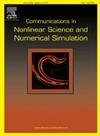An improved stochastic method for conducting system probabilistic analysis by solving FPK equations
IF 3.8
2区 数学
Q1 MATHEMATICS, APPLIED
Communications in Nonlinear Science and Numerical Simulation
Pub Date : 2025-06-27
DOI:10.1016/j.cnsns.2025.109083
引用次数: 0
Abstract
This paper proposes an improved stochastic approach to solve the Fokker–Planck–Kolmogorov (FPK) equation for conducting system probabilistic analysis. The FPK equations, associated with the system under random excitation, are solved to provide the probabilistic solutions, which are essential for system reliability analysis. The proposed method is developed based on the optimization-oriented exponential-polynomial-closure (OEPC) method, and enhances OEPC by ensuring the limitation property of the probabilistic solution, named ’improved OEPC’ method. The key innovation of this study lies in introducing constraints for undetermined parameters to ensure the limitation property of the probabilistic solution. The limitation property means that the solution of FPK approaches zero as the state variables in FPK approach infinity. This improvement guarantees the solution accuracy across a wider spatial range when dealing with rare events, such as system failures of mechanical structures. The methodology is verified by investigating three different types of system: the Duffing oscillator, the ship rolling system, and the wind-excited frame tower system. The results show that the improved OEPC method significantly enhances the tail behavior of the probabilistic solution for complex nonlinear stochastic systems compared to the conventional OEPC method. Additionally, the improved OEPC method outperforms the Gaussian closure method in terms of solution accuracy and demonstrates considerably higher efficiency compared to Monte Carlo simulation.
求解FPK方程进行系统概率分析的改进随机方法
本文提出了一种改进的求解Fokker-Planc k-Kolmogorov (FPK)方程的随机方法,用于进行系统概率分析。对随机激励下系统的FPK方程进行了求解,得到了系统可靠性分析的概率解。该方法是在面向优化的指数多项式闭包(OEPC)方法的基础上发展起来的,并通过保证概率解的局限性来增强OEPC,称为“改进的指数多项式闭包”方法。本文的创新之处在于对待定参数引入约束,保证了概率解的有限性。极限性质意味着当FPK中的状态变量趋于无穷时,FPK的解趋于零。这种改进保证了在处理罕见事件(如机械结构的系统故障)时,解决方案在更广泛的空间范围内的准确性。通过研究三种不同类型的系统:Duffing振荡器、船舶滚动系统和风激框架塔系统,验证了该方法的有效性。结果表明,与传统的OEPC方法相比,改进的OEPC方法显著提高了复杂非线性随机系统概率解的尾部行为。此外,改进的OEPC方法在求解精度方面优于高斯闭包方法,并且与蒙特卡罗模拟相比显示出相当高的效率。
本文章由计算机程序翻译,如有差异,请以英文原文为准。
求助全文
约1分钟内获得全文
求助全文
来源期刊

Communications in Nonlinear Science and Numerical Simulation
MATHEMATICS, APPLIED-MATHEMATICS, INTERDISCIPLINARY APPLICATIONS
CiteScore
6.80
自引率
7.70%
发文量
378
审稿时长
78 days
期刊介绍:
The journal publishes original research findings on experimental observation, mathematical modeling, theoretical analysis and numerical simulation, for more accurate description, better prediction or novel application, of nonlinear phenomena in science and engineering. It offers a venue for researchers to make rapid exchange of ideas and techniques in nonlinear science and complexity.
The submission of manuscripts with cross-disciplinary approaches in nonlinear science and complexity is particularly encouraged.
Topics of interest:
Nonlinear differential or delay equations, Lie group analysis and asymptotic methods, Discontinuous systems, Fractals, Fractional calculus and dynamics, Nonlinear effects in quantum mechanics, Nonlinear stochastic processes, Experimental nonlinear science, Time-series and signal analysis, Computational methods and simulations in nonlinear science and engineering, Control of dynamical systems, Synchronization, Lyapunov analysis, High-dimensional chaos and turbulence, Chaos in Hamiltonian systems, Integrable systems and solitons, Collective behavior in many-body systems, Biological physics and networks, Nonlinear mechanical systems, Complex systems and complexity.
No length limitation for contributions is set, but only concisely written manuscripts are published. Brief papers are published on the basis of Rapid Communications. Discussions of previously published papers are welcome.
 求助内容:
求助内容: 应助结果提醒方式:
应助结果提醒方式:


